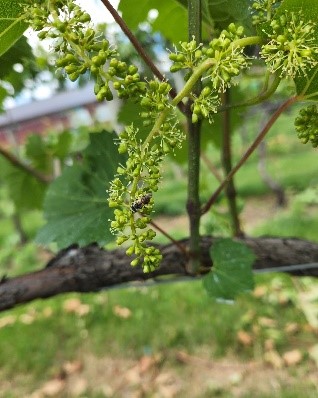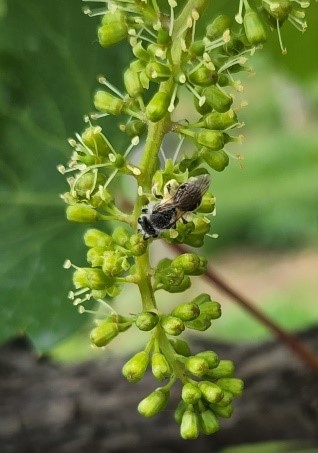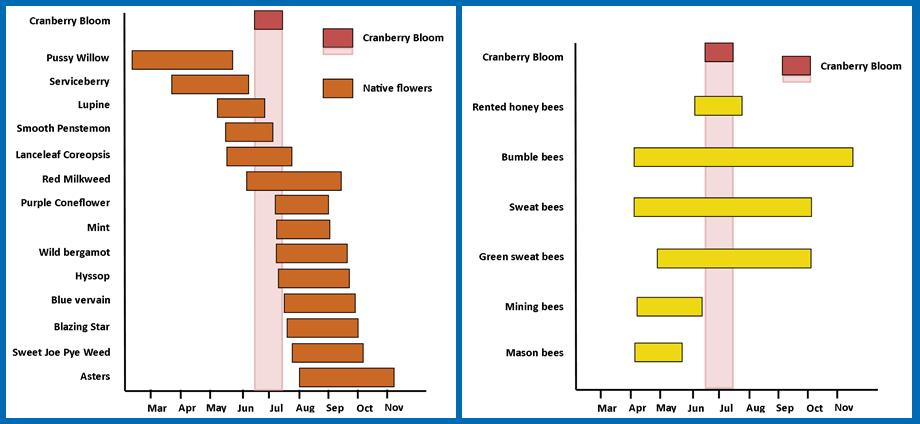Grape Insects at Bloom Time
At this time, most vineyards are in bloom with specific grape varieties being at different stages of bloom. Bloom in grape (Figure 1) is somewhat unique amongst the fruit crops we grow in Wisconsin, as the flowers possess both male and female reproductive parts and can self-pollinate, with some assistance from gravity and wind. Thus, grape plants can bear fruit without needing external pollinators and we often do not think about bees when thinking about grapes. However, if you look closely at Figure 1, you can actually see (blown up in Figure 2) that bees do still visit grape flowers and are an inherent component of the vineyard agroecosystem. Graduate student Mitchell Lannan, who is working on Japanese beetle management evaluating an attract-and-kill strategy, is also documenting bees present in vineyards. With the help of Entomology undergraduate student Allison Lopina, they are recording the presence of bees visiting grape flowers and we are excited to see quite a few native bees in grape (Figure 3), with one instance of nearly 300 bee observations at one vineyard on the morning of June 15! We also know that bees are present in the vineyard, visiting dandelion, clover and other weed flowers in the alleyways, and thus, it is important to think about protecting pollinators during bloom, even in vineyards.


Protecting pollinators on your farm. To protect pollinators and increase bee health, you can think about implementing a pollinator protection plan that will reduce pesticide exposure to bees by following these four straightforward approaches:
- Practicing integrated pest management (IPM). IPM, which involves monitoring for pests and using a variety of appropriate management strategies – such as cultural, biological, host plant resistance, chemical – is important to implement in fruit crops where bees are ever so present.
- Spraying when bees are least active. Most bees forage from early morning until shortly before sunset. Therefore, the best time to apply a pesticide, especially during bloom (if allowed by the pesticide label), is in the late evening or at night.
- Limiting pesticide drift. Reduce pesticide drift by calibrating your sprayer to optimize spray pressure, amount, and volume, selecting drift-reducing nozzles, avoiding pesticides with small particles that easily drift, and spraying when winds are under 10 mph and when relative humidity is above 50%.
- Using insecticides and fungicides that have reduced risk for bees. Some pesticides are less toxic to bees and should be used preferentially over broader spectrum pesticides, especially around the bloom period. For more information on how to select pesticides, please see this Oregon State publication or download the app “Reduce bee poisoning from pesticides”.
- Overall, it is highly recommended to not spray any pesticides during bloom.

Promoting pollinators on your farm. Increasing pollinator abundance and diversity to promote a healthy, sustainable, and vibrant vineyard could easily be accomplished by providing a diversity of sources of nectar and pollen, for example by planting flowering cover crops or pollinator gardens in the alleyway or the field edges. Some common native plants to consider for a pollinator garden are listed in Figure 4 Left panel, with their approximate bloom times in relation to cranberry (Guédot and van Zoeren, 2018). You can also see in this figure the approximate flight period for different bee groups. While this figure relates to cranberry bloom, you can easily use this information for grape. Wild bees also need places to build their nests. Approximately 70% of native bees nest underground and need areas of bare, sandy, or loamy soil to build their nests. The remaining 30% build nests by tunneling into stumps or twigs, or by constructing nests in cavities (e.g., in mounds of tall grasses, in debris piles, or in deserted rodent nests).

Figure 4. LEFT: Approximate bloom times for plants that are recommended to be grown near cranberry marshes as a supplemental nectar and pollen source for cranberry pollinators. RIGHT: Approximate flight periods for major groups of bees (including native species) found in cranberry marshes. The pink columns in both graphs represent the approximate time of cranberry bloom.
The week of June 20 is pollinator week in Wisconsin, so please help protect and promote pollinators on your farm.
Happy growing season!
References
Guédot C. and van Zoeren J. 2018. Protecting pollinators and improving pollination on Wisconsin cranberry marshes. https://cdn.shopify.com/s/files/1/0145/8808/4272/files/A4155.pdf
Louisa Hooven, Ramesh R. Sagili, and Erik Johansen. 2016. How to Reduce Bee Poisoning from Pesticides
https://catalog.extension.oregonstate.edu/sites/catalog/files/project/pdf/pnw591.pdf
This article was posted in Grapes, Insects and tagged bloom, bloom time, Christelle Guédot, grape insects, Grapes, insects.
